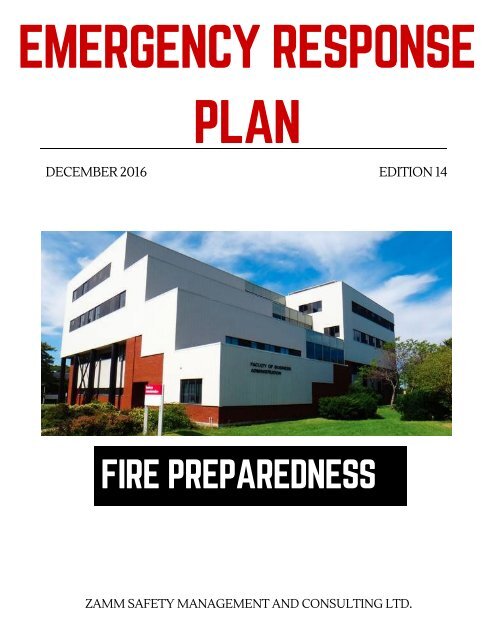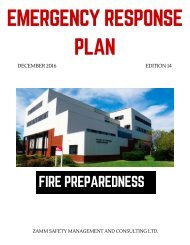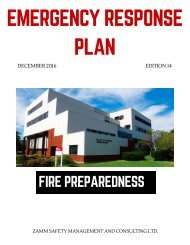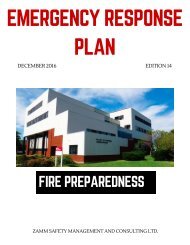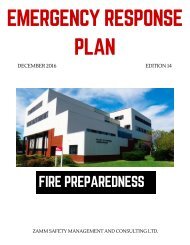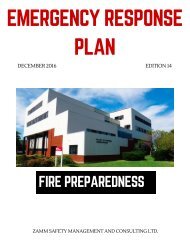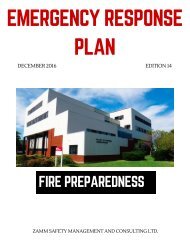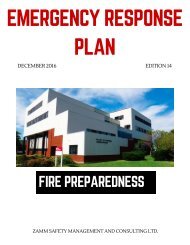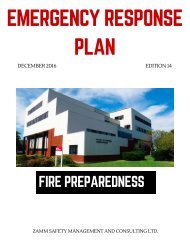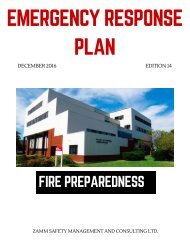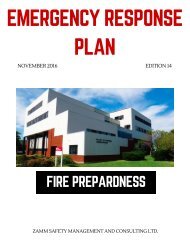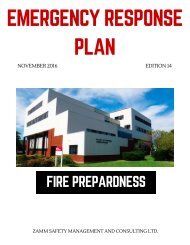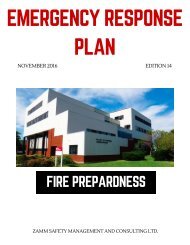OHS Assignment V9
Create successful ePaper yourself
Turn your PDF publications into a flip-book with our unique Google optimized e-Paper software.
EMERGENCY RESPONSE<br />
PLAN<br />
DECEMBER 2016<br />
EDITION 14<br />
FIRE PREPAREDNESS<br />
ZAMM SAFETY MANAGEMENT AND CONSULTING LTD.
WHAT IS AN EMERGENCY?<br />
An emergency is any sudden set of<br />
circumstances that require an immediate<br />
action (Kelloway, Francis & Gatien, 2014).<br />
Emergencies can be either<br />
naturally occurring or the<br />
result of man-made decisions.<br />
While the probability of these<br />
disasters happening may be<br />
low, organizations must be fully<br />
equipped to effectively handle<br />
emergency situations if they<br />
were to emerge. As Wiercinski<br />
(2013) notes, effective<br />
JASON RUBIO<br />
emergency planning is<br />
accessible and achievable for<br />
all.
3 TYPES OF EMERGENCIES<br />
Naturally-occurring<br />
emergencies can include<br />
weather disasters such as:<br />
· Flooding<br />
· Blizzards<br />
· Snow<br />
JASON RUBIO<br />
Man-made emergencies can<br />
include disasters such as:<br />
· Oil Spills<br />
· Workplace Violence<br />
· Fires<br />
Technological emergencies can<br />
include such disasters as:<br />
· Telecommunications JASON failures RUBIO<br />
· Electrical power loss<br />
· Cyberterroism
BENEFITS OF AN EMERGENCY<br />
RESPONSE PLAN<br />
Although many organizations focus on<br />
how they will respond during an<br />
emergency, true emergency planning<br />
also includes anticipating emergencies,<br />
planning for emergencies, executing<br />
the plan when needed, getting back to<br />
work and refining the plan in the light<br />
of new learning (Kelloway et al., 2011).<br />
Having a plan ready in case of an<br />
emergency can lessen the impact of<br />
the incident. According to Pearson et<br />
al. (1997) step two of the five-stage<br />
crisis management process is<br />
preparation, which involves the<br />
creation of a response plan (Pearson et<br />
al., 1997).<br />
It is important for businesses to have a<br />
disaster recovery plan in the event of a<br />
disaster.<br />
This typically includes a formally<br />
drafted plan of detailed steps to be<br />
taken after a disaster occurs, along<br />
with contact information for<br />
employees, contacts and vendors,<br />
alternative locations for conducting<br />
business, and critical resources that<br />
need to be recovered (Polygon, 2016).<br />
JASON RUBIO<br />
DO YOU KNOW . . .<br />
According to Zhou et al. (2008), having an<br />
emergency response plan specifically<br />
designed for fire disasters can help<br />
people save their own lives.<br />
Your Fire Department’s<br />
emergency number?<br />
Your fire escape plan?<br />
Your designated meeting<br />
place in the event of a fire?<br />
Who your floor fire<br />
emergency officer is?<br />
The location of the nearest<br />
fire extinguisher?<br />
The location of the nearest<br />
fire alarm station?<br />
The location of the nearest<br />
two exits?<br />
Who needs assistance in<br />
the event of an emergency?<br />
(Fire Prevention Canada,<br />
2016)
PRE-<br />
CONTACT<br />
STAGE
ORGANIZATIONAL CHECK LIST<br />
Know your region and the types of disaster most likely to<br />
impact your business<br />
Assess the capacity of employees in preparing and<br />
responding for an emergency<br />
Identify internal/external emergency response resources<br />
that will provide assistance during the emergency<br />
Identify plan for employees, vendors and customers if the<br />
business were to shut down for a few days<br />
Identify a First Aid team<br />
JASON RUBIO<br />
Obtain necessary safety equipment<br />
Write a plan for responding to emergencies<br />
Develop a Business Continuity Plan
SUPPLIES<br />
FIRE EXTINGUISHERS<br />
Perhaps the most commonly thought of tool in fire safety are fire extinguishers.<br />
However, it is important to note that the size and nature of your business may determine<br />
the type and number of extinguishers you will need. For example, ‘there are three basic<br />
classes of fire extinguishers. Fire extinguishers must be labeled to show the class of fire<br />
they can extinguish.<br />
CLASS A<br />
CLASS B CLASS C<br />
ORDINARY<br />
COMBUSTIBLES<br />
SUCH AS PAPER,<br />
WOOD, RUBBISH,<br />
DRAPES AND<br />
UPHOLSTERY.<br />
FLAMMABLE<br />
LIQUIDS SUCH AS<br />
GASOLINE, OILS,<br />
SOLVENTS, PAINTS<br />
AND FLAMMABLE<br />
GASES.<br />
FLAMMABLE GASES<br />
SUCH AS PROPANE,<br />
BUTANE, METHANE<br />
ETC<br />
CLASS D CLASS E CLASS F<br />
METALS SUCH<br />
AS ALUMINIUM,<br />
MAGNESIUM,<br />
TITANIUM ETC<br />
FIRES<br />
INVOLVING<br />
JASON RUBIO<br />
ELECTRICAL<br />
APPARATUS<br />
COOKING OIL &<br />
FAT ETC<br />
ALTHOUGH YOU SHOULD DEFINITELY HAVE A FIRE EXTINGUISHER, THIS DOES NOT MEAN THAT YOU SHOULD<br />
DEFINITELY USE IT. ONLY FIGHT A FIRE IF:<br />
THE FIRE IS SMALL AND NOT SPREADING<br />
OCCUPANTS HAVE BEEN ALERTED<br />
EVERYONE HAS LEFT OR IS LEAVING THE BUILDING<br />
HELP HAS BEEN CALLED<br />
YOU HAVE A CLEAR ESCAPE ROUTE THAT WON'T BE BLOCKED BY FIRE<br />
YOU KNOW HOW TO OPERATE YOUR EXTINGUISHER AND ARE AWARE OF ITS CAPABILITIES<br />
Don't fight a fire in any other circumstance. Leave the premises immediately, close off<br />
the area and call 9-1-1 from a neighbour's home.<br />
It is important for businesses to have a disaster recovery plan in the event of a disaster.
SMOKE DETECTORS<br />
SUPPLIES<br />
It is also important to consider smoke detectors and how to properly<br />
locate and install them. According to Fire Prevention Canada, the<br />
following should be done …<br />
Keep alarms at least 60 cm (2 feet) from any Read and follow the manufacturer’s<br />
corner<br />
instructions carefully<br />
Do not recess smoke alarms in walls or<br />
For best performance, an alarm should be<br />
ceilings<br />
mounted on the ceiling in or near the<br />
Smoke alarms in rooms with ceiling slopes<br />
centre of the room, hall or stairway, and<br />
greater than 30 cm (one foot) rise per 2.4 m at the head of each stairway leading to an<br />
(eight feet) horizontally should be located JASON RUBIO occupied area<br />
on the high side of the room<br />
Optimum location for wall mounts is at<br />
Avoid locating an alarm at the peak of an<br />
least 15 cm (6 inches) from the ceiling but<br />
“A” frame type ceiling<br />
not more than 30 cm (19 inches) from it<br />
Never paint a smoke alarm<br />
Avoid installing where the temperature<br />
Keep alarms 60 to 90 cm (two to three feet) is less than 5oC (41oF) or exceeds 48oC<br />
away from light fixtures<br />
(119oF)<br />
Test your fire alarm monthly and clean it<br />
Keep alarms away from doors and<br />
every six months<br />
windows<br />
Never locate an alarm in front of an air<br />
register, fans or vents
FIRE WARDENS & DRILLS<br />
It is important to remember to contact the appropriate authority members should an emergency<br />
occur. Legal requirements may apply to certain organizations such as notifying the Ministry of<br />
Labour, Police, Fire Department, etc. It is important to know phone numbers and contact<br />
information for emergency response units, especially if organizations fall outside the 911<br />
emergency system. Additionally, it is crucial to be familiar with outside resources and contact<br />
information for organizations such as the red cross and emergency relief programs.<br />
Fire wardens are essential roles within an organization that can help minimize the risk of danger<br />
and damage during a fire or emergency. Their primary responsibilities are to assist in the<br />
implementation of safety work practices, monitor potential hazards, to lead fire drills and assist<br />
with evacuation should an emergency occur, and ensure all workers are accounted for.<br />
Unfortunately, there is a lack of legislature regarding specific requirements of fire wardens,<br />
therefor making their roles and requirements different and subjective for each organization.<br />
JASON RUBIO<br />
Fire drills should be performed regularly as well as unannounced.<br />
Rehearsals are an important part of training and add a practical<br />
and truly situational element to fire preparedness. Simulating<br />
disasters will help employees effectively deal with real<br />
emergencies. Drills help to test the responsive capabilities of an<br />
organization. Evaluation of a fire drill can be conducted by<br />
examining such factors as: Reporting, Initial Actions, Mustering<br />
and Preparation, First-Aid Capabilities, and Use of Fire<br />
Extinguishing Systems (Fu, J., Jin, Y,. & Wu, J., 2014). Additionally,<br />
the fire drill can also be evaluated on evacuation times and head
OTHER CONSIDERATIONS<br />
There are four key considerations to make when designing a<br />
emergency response plan with respect to fire prevention and<br />
preparation: Structural Design, Barriers, Detection and<br />
Suppression, Storage.<br />
Structural Design: the standards and<br />
building designs required by provincial and<br />
federal fire codes and other regulations.<br />
The overall design of a building can impact<br />
how quickly a fire is able to spread.<br />
Barriers: Specific fire barriers should be<br />
well maintained to ensure effectiveness in<br />
an emergency. Additionally, walls and<br />
floors constructed of nonflammable<br />
materials such a concrete can serve as<br />
barriers to fires.<br />
Detection and Suppression: Most commonly<br />
JASON RUBIO<br />
found as smoke and heat detector systems<br />
in buildings. These systems are often linked<br />
to and can trigger sprinkler systems and<br />
alter local fire departments of potential<br />
fires.<br />
Storage: Items and materials that are highly<br />
combustible or flammable should be stored<br />
away from potential sources of fires, highrisk<br />
areas, and from exits to ensure<br />
evacuations routes are not inhibited
CONTACT<br />
STAGE
FIRE CONTACT<br />
A Fire is a chemical process in which fuel, oxygen, and heat combine<br />
to create a disastrous condition. The products of fire are gases, flame,<br />
heat, and smoke.<br />
JASON RUBIO
EMERGENCY CONTACTS<br />
Emergency First Aid and Medical Attention<br />
If an emergency were to happen, organizations must have the proper first<br />
aid procedures to address any incidents that can occur. The necessary first<br />
aid will vary based upon the nature of the emergency along with the type<br />
and size of the organization.<br />
To best prepare an organization, management must:<br />
· Ensure employees are trained in first aid/CPR<br />
· Ensure that fire extinguishers are available on site<br />
JASON RUBIO<br />
RELEVANT EMERGENCY CONTACT NUMBERS FOR YOUR ORGANIZATION<br />
Emergency Response: 9-1-1<br />
Canadian Red Cross: (709) 758-8400<br />
CEP Emergency Response - St. John's Campus: 864-4100<br />
St. John's Regional Fire Department: (709) 758-3229<br />
St John Ambulance: (709) 726-4200<br />
*If located outside St. John's, please contact your local emergency services*
POST-<br />
CONTACT<br />
STAGE
GETTING BACK TO NORMAL<br />
Critical Incident: any situation or event faced by emergency, public safety personnel or<br />
employees causing a distressing, dramatic or profound change in their physical<br />
(physiological) or psychological functioning.<br />
After a critical incident, psychological reactions are very common and predictable.<br />
Critical Incident Stress Debriefing (CISD) is a valuable tool following a life-threatening<br />
event.<br />
Two components of CISD: Defusing and Debriefing<br />
Debriefing allows those involved with the incident to process the event and reflect on<br />
its impact.<br />
Defusing: allows ventilation of emotions and thoughts associated with the crisis event<br />
No longer than the first 24-72 hours after initial impact of critical event, least effective<br />
as length of time increases.<br />
JASON RUBIO
EVACUATION PLAN
REFERENCES<br />
City of Toronto. 2016. Fire Extinguishers. Retrieved from http://www1.toronto.ca/wps/portal/contentonly?<br />
vgnextoid=0d81a069d81f1410VgnVCM10000071d60f89RCRD&vgnextchannel=e1df3840456e1410VgnVCM1000<br />
0071d60f89RCRD<br />
Davis, J. A. (2013, February 12). Critical incident stress debriefing from a traumatic<br />
event. Retrieved from: https://www.psychologytoday.com/blog/crimes-and- misdemeanors/201302/critical-incidentstress-debriefing-traumatic-event<br />
Fire Prevention Canada. (2016). Fire Escape Plan. Retrieved from<br />
http://www.fiprecan.ca/fire-escape-plan/<br />
Fire Prevention Canada. (2016). Smoke Alarms. Retrieved from<br />
http://www.fiprecan.ca/smoke-alarms/<br />
Fu J, Wu J., Jin Y. (2014). Effectiveness Evaluation on Fire Drills for Emergency and<br />
PSC Inspections on Board. TransNav, the International Journal on Marine Navigation and Safety of Sea Transportation,<br />
8(2), pp. 229-236<br />
Kelloway, E., Francis, L., Gatien, B. (2011). Management of Occupational Health and<br />
Safety. United States of America: Nelson Education Series.<br />
Payant, R. (2016) Emergency Management for Facility and Property Managers.<br />
New York: McGraw-Hill Education.<br />
Pearson, C., Misra, S., Clair, J., Mitroff, I. (1997). Managing the Unthinkable.<br />
Organizational Dynamics.Vol. 26(2), pp.51-64. DOI: 10.1016/S0090-2616(97)90005-X<br />
Small Business Fire Damage Recovery Plans. (2016). Polygon. Retrieved from<br />
http://www.polygongroup.com/en-US/blog/small-business-fire-damage-recovery-plas/<br />
The American National Red Cross. (2009). Get started: Emergency preparedness<br />
checklist for small businesses. Retrieved from United States Department of Labor Retrieved from :<br />
https://www.osha.gov/dte/grant_materials/fy07/sh- 16618-07/sm_business_emergency_checklist.pdf<br />
Weekes, J. (2014, August 7). 7 Key Duties of a Fire Warden. Retrieved from<br />
http://www.healthandsafetyhandbook.com.au/7-key-duties-of-a-fire-warden/<br />
Wiercinski, A.K. (2013) Emergency Planning and Response for Libraries, Archives<br />
and Museums. Australian Academic & Research Libraries. 44(3), 181-182. doi: 10.1080/00048623/2013/817282<br />
Zhou, S., Zhang, T., Qin, H. (2008). The Fire Emergency Response Plan Simulation Based<br />
on Particle System. Intelligent Networks and Intelligent Systems. DOI: 10.1109/ICINIS.2008.120


